mta
30 Products
Active Filters
Filter by Category
Filter by Color
Filter by Size
Filter by Price
Min Price:
Max Price:
-

 $30.00 – $80.00
$30.00 – $80.00The Metro North Port Jervis Line runs from Port Jervis where Pennsylvania, New Jersey and New York meet, through Sullivan and Rockland Counties, NY, and then through northern New Jersey to the Hoboken Terminal in Hoboken, NJ. Much of the Port Jervis Line started as the New York and Erie Railroad Main Line, opening to Port Jervis in 1848. The original line ran through the towns of Monroe, Chester, Goshen, and Middletown but this stretch was abandoned in 1984 when Metro North chose to move service to a longer, but faster and straighter, route.
The Erie Main Line once reached Buffalo and Chicago via the Southern Tier of New York State but lost money and ridership after World War II. The Port Jervis Line is one of two Metro North lines which run through New Jersey. The tracks in New York are owned and operated by Metro North but the tracks in New Jersey are owned and operated by New Jersey Transit. Port Jervis trains run to Hoboken Terminal but transfers are available at Secaucus Junction for service to Penn Station.
Printed on Satin finish 80# cover stock – 220 GSM. Made in the USA! Standard production time is 5 days. Allow more time for shipping.
Select options This product has multiple variants. The options may be chosen on the product page -
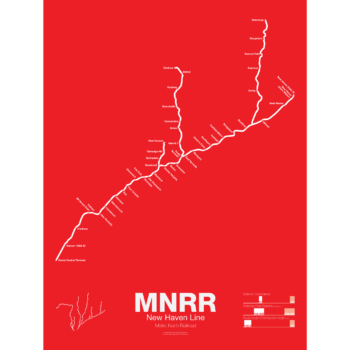
 $30.00 – $80.00
$30.00 – $80.00The Metro North New Haven Line runs from Grand Central Terminal to New Haven, CT with branches to New Canaan, Danbury, and Waterbury. Most of the Main Line runs along Amtrak’s Northeast Corridor, is owned by Connecticut DOT and is leased to Metro North for operations. The line started in 1849 connecting New York and New Haven. In 1872 the line was merged into J. P. Morgan’s giant New York, New Haven, and Hartford Railroad which was the largest railroad in New England at the time.
Today the New Haven Line ranks as the busiest rail line in the United States.
Printed on Satin finish 80# cover stock – 220 GSM. Made in the USA! Standard production time is 5 days. Allow more time for shipping.
Select options This product has multiple variants. The options may be chosen on the product page -

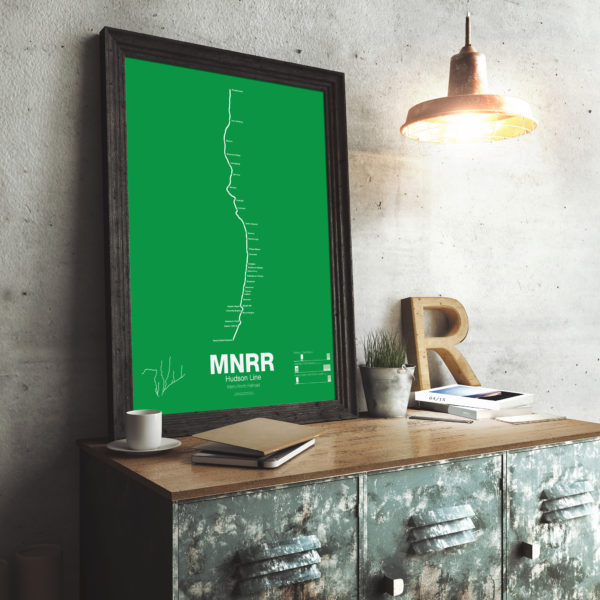 $30.00 – $80.00
$30.00 – $80.00The Metro North Hudson Line runs from Grand Central Terminal to Poughkeepsie along the Hudson River and also serves Amtrak lines to Chicago, Vermont, and Montreal. The Hudson Line was chartered in 1846 to connect Troy, NY with Manhattan and by 1851 the line had been completed to Chambers St. Cornelius Vanderbilt bought the line in 1864 and merged it with the Harlem Line to create the New York Central. The line eventually stretched all the way to Chicago and served both commuter and intercity travelers.
After World War II ridership declined and the New York Central merged with the Pennsylvania Railroad but it still couldn’t compete. The Hudson Line became part of the Conrail network and commuter service was cut back to Poughkeepsie. In 1983 Metro North took over all operations of the line and invested in new tracks, stations and trains.
Printed on Satin finish 80# cover stock – 220 GSM. Made in the USA! Standard production time is 5 days. Allow more time for shipping.
Select options This product has multiple variants. The options may be chosen on the product page -
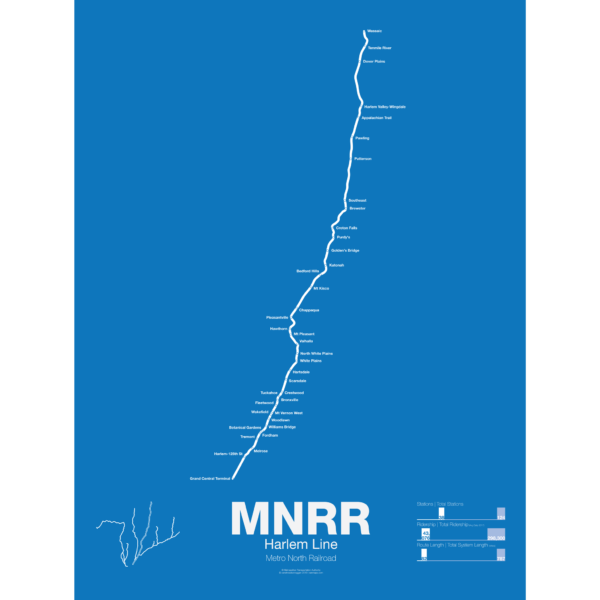
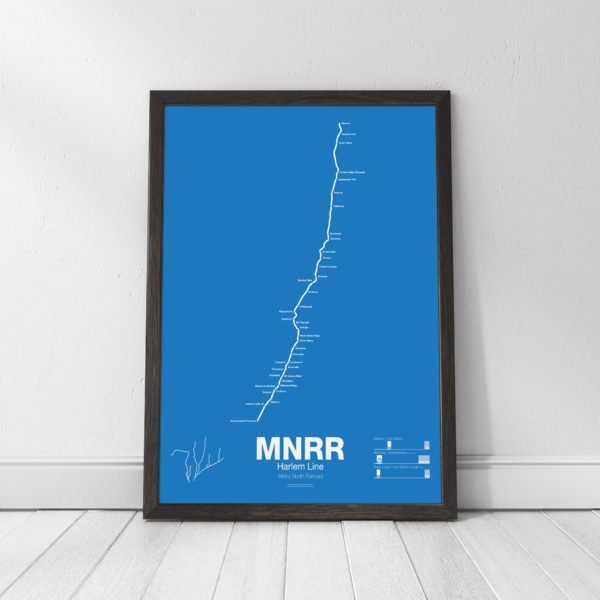 $30.00 – $80.00
$30.00 – $80.00The Metro North Harlem Line runs from Grand Central Terminal in Manhattan to Wassic in Dutchess County, running through the posh suburbs in Westchester. The railroad began as a horse drawn streetcar line from lower Manhattan to the distant suburb (at the time) of Harlem in 1831. The line quickly grew with ambitions to reach Albany and beyond but only got to Chatham, NY in 1852 where riders could transfer to other trains to Boston, Albany, and to points north and west. Originally trains would end at 26th St and Park Ave in Manhattan but in 1871 the new Grand Central Depot was opened at 42nd St, at the time far from the heart of the city.
The Harlem Line was leased to the mighty New York Central Railroad in 1873 and would be a major part of their system until after World War II when the NYC and Pennsylvania Railroad merged. This couldn’t stop the losses and by 1971 a deal was stuck to lease the railroad to the Metropolitan Transportation Authority and was merged into the new Metro North Railroad. Service between Chatham and Dover Plains was ended and the MTA began to invest in new stations and modern equipment. In 2000 Metro North completed a reactivation of track from Dover Plains to Wassaic.
Printed on Satin finish 80# cover stock – 220 GSM. Made in the USA! Standard production time is 5 days. Allow more time for shipping.
Select options This product has multiple variants. The options may be chosen on the product page -
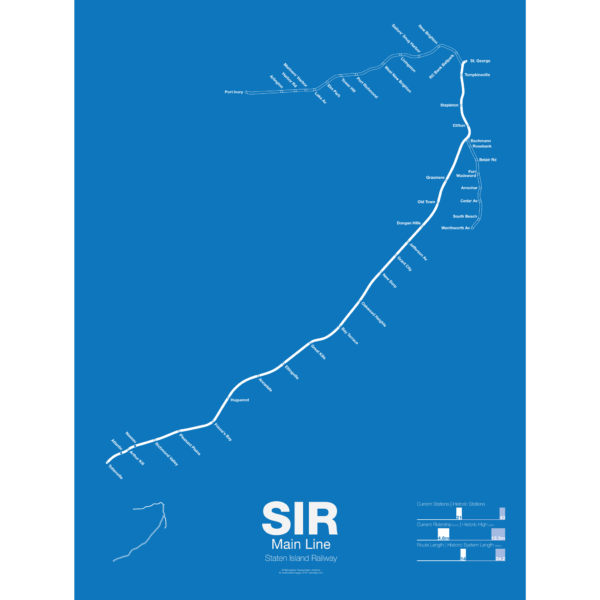
 $30.00 – $80.00
$30.00 – $80.00The Staten Island Railway was founded in 1851 as a way to connect the island to Cornelius Vanderbilt’s ferry to Manhattan. It was expanded in the 1880s with a North Shore Branch which connected the island to New Jersey and a South Beach Branch which ran past Fort Wadsworth to the beaches on the islands southeastern shore. The railroad served both passenger and freight traffic. In the 1920s the railroad was electrified in anticipation of a connection to the subway in Brooklyn but the tunnel was never built. After World War II ridership dropped as more residents chose to drive or take cheaper buses over the new bridges to New Jersey. Service on the North Shore and South Beach Branches was ended in 1953, though the North Shore Branch was (and still partially is) still used for freight. Plans have been floated to reactive the North Shore Branch as rail or bus rapid transit but so far nothing has been done.
This poster shows the existing Main Line and two former branches, the North Shore Branch to Port Ivory and the South Beach Branch to Wentworth Ave.
Printed on Satin finish 80# cover stock – 220 GSM. Made in the USA! Standard production time is 5 days. Allow more time for shipping.
Select options This product has multiple variants. The options may be chosen on the product page -
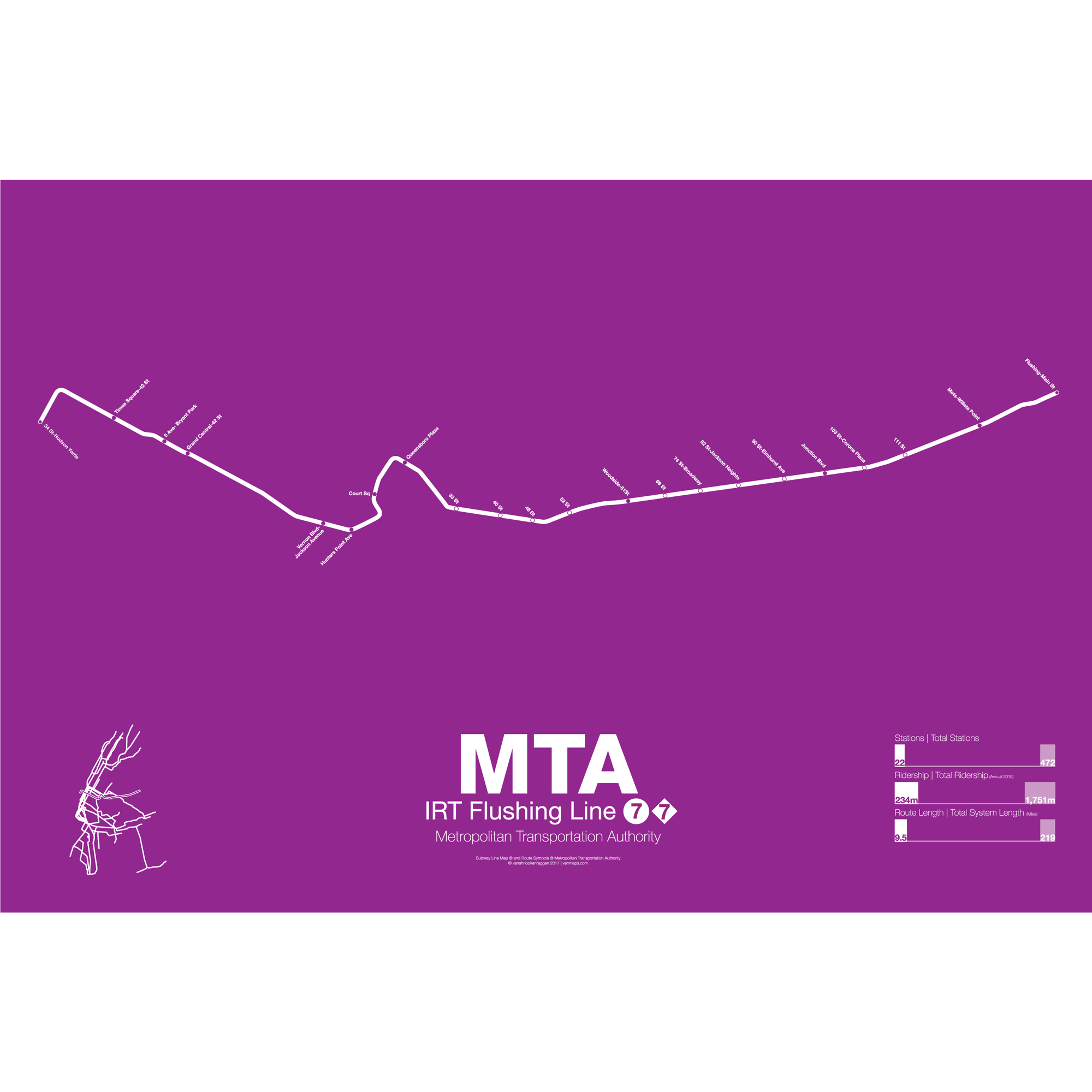
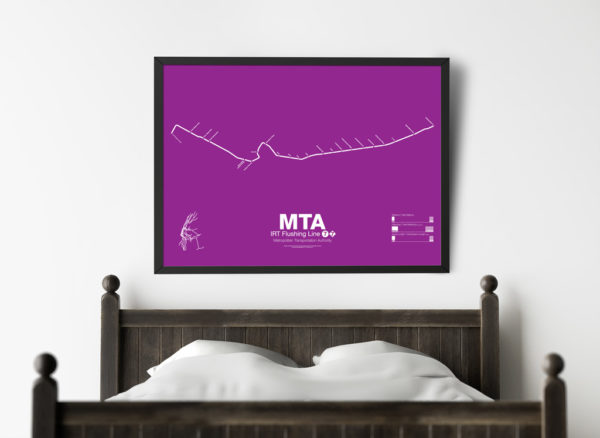 $30.00 – $80.00
$30.00 – $80.00The IRT Flushing line caries the 7 line (local and express service) from Times Sq-42nd St to Flushing Main St and runs from Midtown Manhattan through Long Island City, Sunnyside, Woodside, Elmhurst, Corona, and Flushing, Queens. Because of the high concentration of so many diverse ethnic enclaves though which the Flushing line runs it is colloquially known as the “International Line”.
The line has its origins well before the New York City subway opened (in 1904). Originally conceived as a commuter rail tunnel to bring Long Island trains into midtown from Long Island City the tunnel broke ground in 1892 but was shut a year later after a series of accidents. August Belmont stepped in a decade later and financed the tunnel himself as a way to run trolley cars as shuttle service. Opened in 1907, the city purchased the tunnel in 1913 to retrofit it for the expanding subway system.
The Flushing line runs elevated from Hunts Point Ave to Mets-Willets Point Ave where it dives into a short tunnel before terminating at Main St. The elevated sections of track are built with a third track for express service which only makes stops at Queensboro Plaza, Woodside-61st St, Junction Blvd, Mets-Willets Point, and Flushing-Main St. The elevated section through Sunnyside is famous for its ornately designed concrete viaduct along Queens Blvd.
In 2015 an extension west was opened to a new terminal at 34th St-Hudson Yards to serve the new mini-city growing above the LIRR train yards behind Penn Station.
Printed on Satin finish 80# cover stock – 220 GSM. Made in the USA! Standard production time is 5 days. Allow more time for shipping.
Select options This product has multiple variants. The options may be chosen on the product page -
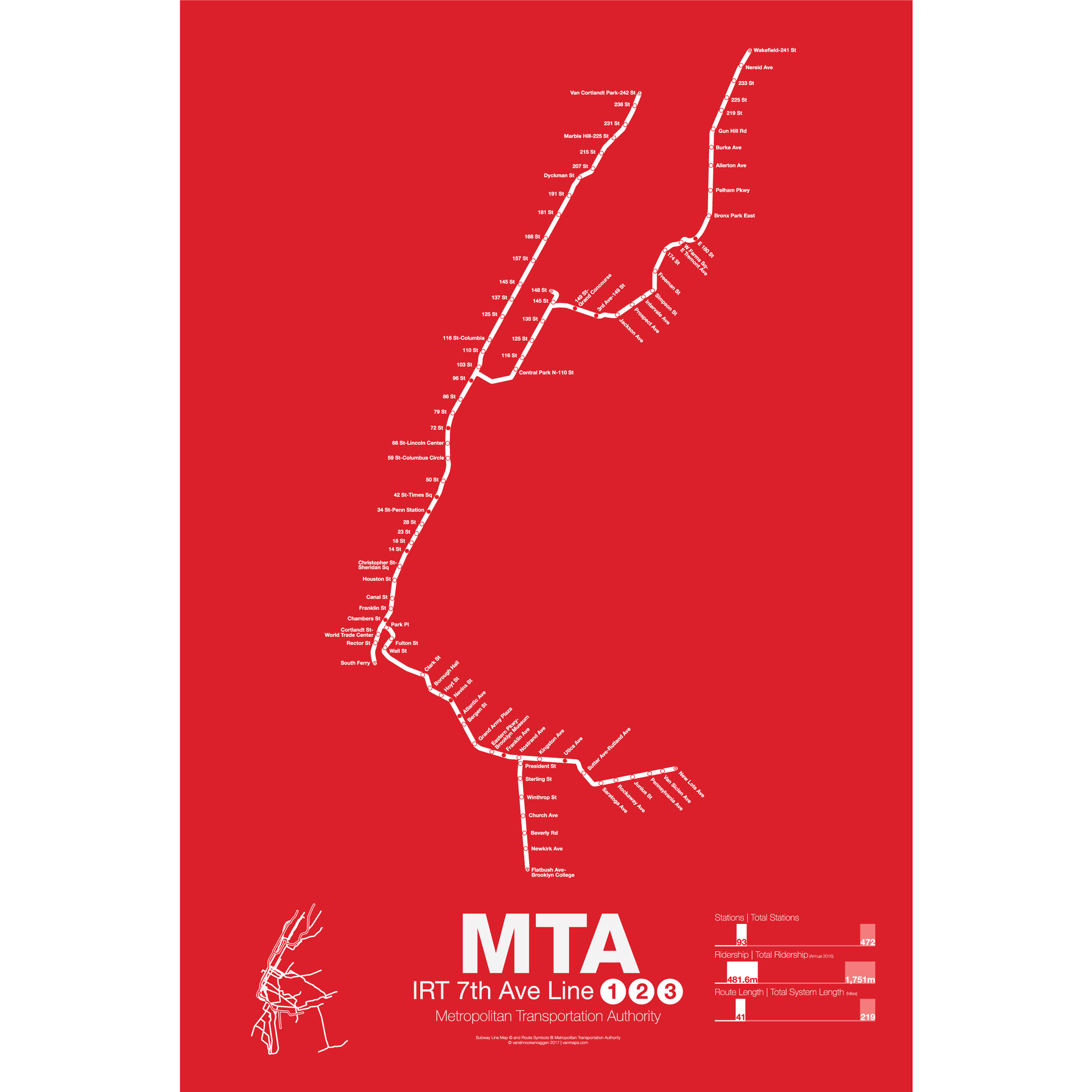
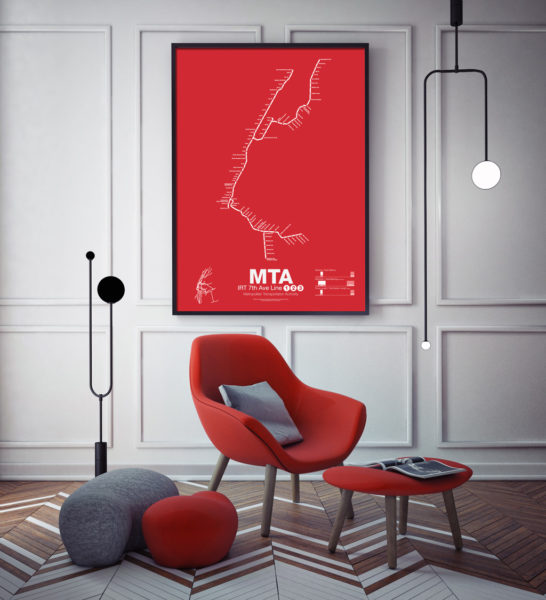 $30.00 – $80.00
$30.00 – $80.00The IRT 7th Ave line is one-half of the original Interborough Rapid Transit (IRT) subway which opened in 1904. Running from 145th St/Broadway to Times Sq at 42nd St/Broadway the original subway swung east under 42nd St and then south at Park Ave to City Hall. When this subway was expanded in 1918 service was rerouted south along 7th Ave to South Ferry and into Brooklyn to Borough Hall and Atlantic Ave.
The 1 train runs all local from Van Cortlandt Park-242nd St in the Bronx to South Ferry at the tip of lower Manhattan. From 1989 to 2005 there was an additional train, the 9, which ran as a “skip-stop” service after 96th St to speed up travel for commuters coming from upper Manhattan. Between 181st and 191st Sts the subway was dug through some of the hardest bedrock in the city and these sections are some of the deepest in the entire system.
2 and 3 trains run express from 96th St to Chambers St at which point they veer east into Brooklyn. After 96th St 2 and 3 trains swing northeast and run under Lenox Ave in Harlem. When this service opened in 1905 it helped Harlem explode with development. 3 trains terminate at 148th St while 2 trains travel into the Bronx where they run up to Wakefield-241st St along the elevated White Plains line.
In Brooklyn the 2 and 3 trains share a subway with IRT Lexington Ave 4 and 5 trains which runs through Borough Hall to Atlantic Ave, under Flatbush Ave to Eastern Parkway and out to Nostrand Ave where 3 trains continue east to New Lots Ave (elevated after Utica Ave). 2 trains run south to Flatbush Ave.
While 2 and 3 trains run express in Manhattan they only run local in Brooklyn.
Printed on Satin finish 80# cover stock – 220 GSM. Made in the USA! Standard production time is 5 days. Allow more time for shipping.
Select options This product has multiple variants. The options may be chosen on the product page -
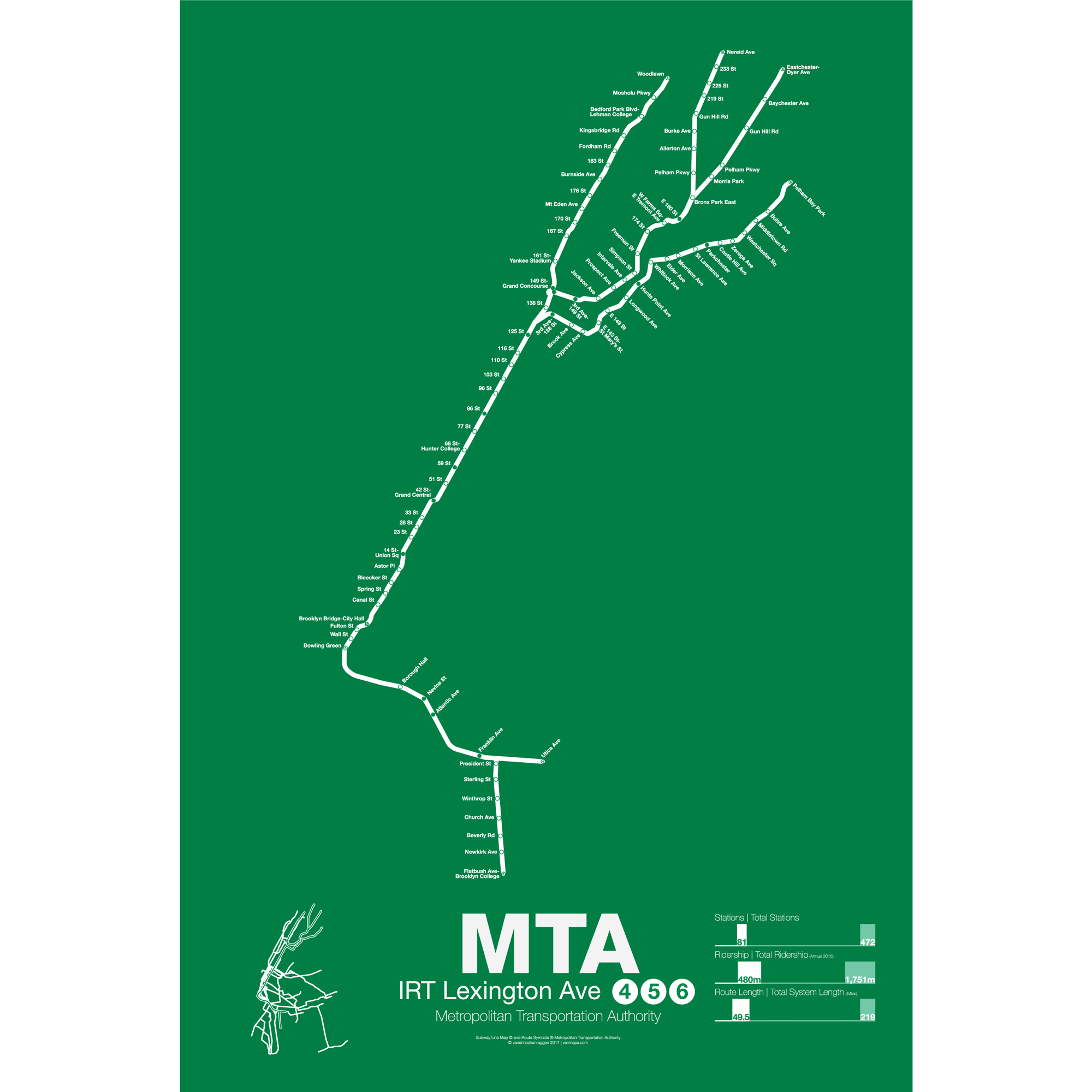
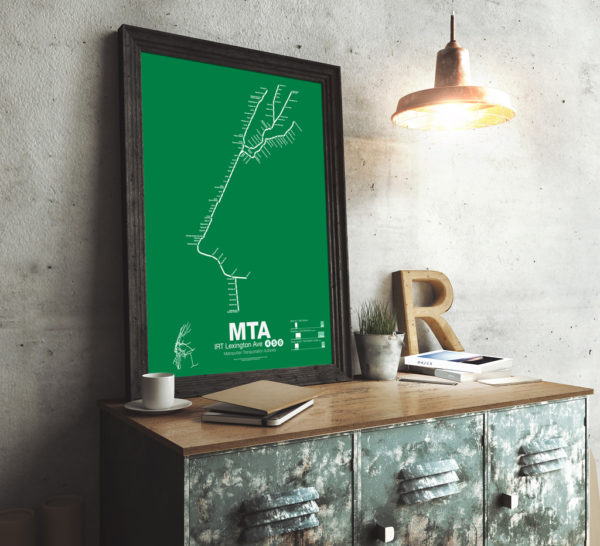 $30.00 – $80.00
$30.00 – $80.00The IRT Lexington Ave line is one half of the original Interborough Rapid Transit (IRT) subway which opened in 1904 running from City Hall to Grand Central along Lafayette St and Park Ave South where it swung west under 42nd St to Times Sq. When the subway was expanded in 1918 service was rerouted north along Lexington Ave and into Brooklyn to Borough Hall and Atlantic Ave.
The IRT Lexington Ave line is the only subway to serve the East Side of Manhattan and averages 1.3 million riders a day, “more than the combined ridership of San Francisco and Boston’s entire transit systems”. Because of this overcrowding is a major issue and has led to the construction of a new subway under 2nd Ave. In Manhattan and Brooklyn Lexington Ave trains run exclusively underground but in the Bronx each line fans out and runs mostly elevated. The 6 train runs along the Pelham Line, a mix of elevated and subway track, and runs local and express service out through Hunts Point, Unionport, Parkchester, and terminating at Pelham Park. The 6 runs all local in Manhattan terminating at Brooklyn Bridge-City Hall.
4 trains run up to Yankee Stadium and north, elevated, along Jerome Ave to Woodlawn. 4 trains run local in the Bronx all times express in Manhattan and all times express in Brooklyn out to Utica Ave/Eastern Parkway. 5 trains join the IRT White Plains line at 149th St-Grand Concourse and shares the elevated line out to 180th St. Here service alternates between using the IRT Dyer Ave line to Eastchester and continuing with the IRT White Plains line to Nereid Ave during rush periods. 5 trains operate local in the Bronx except for rush periods when they run express from 180th St to 3rd Ave-149th St, all express in Manhattan to Bowling Green, and rush periods express to Flatbush Ave in Brooklyn.
Printed on Satin finish 80# cover stock – 220 GSM. Made in the USA! Standard production time is 5 days. Allow more time for shipping.
Select options This product has multiple variants. The options may be chosen on the product page -
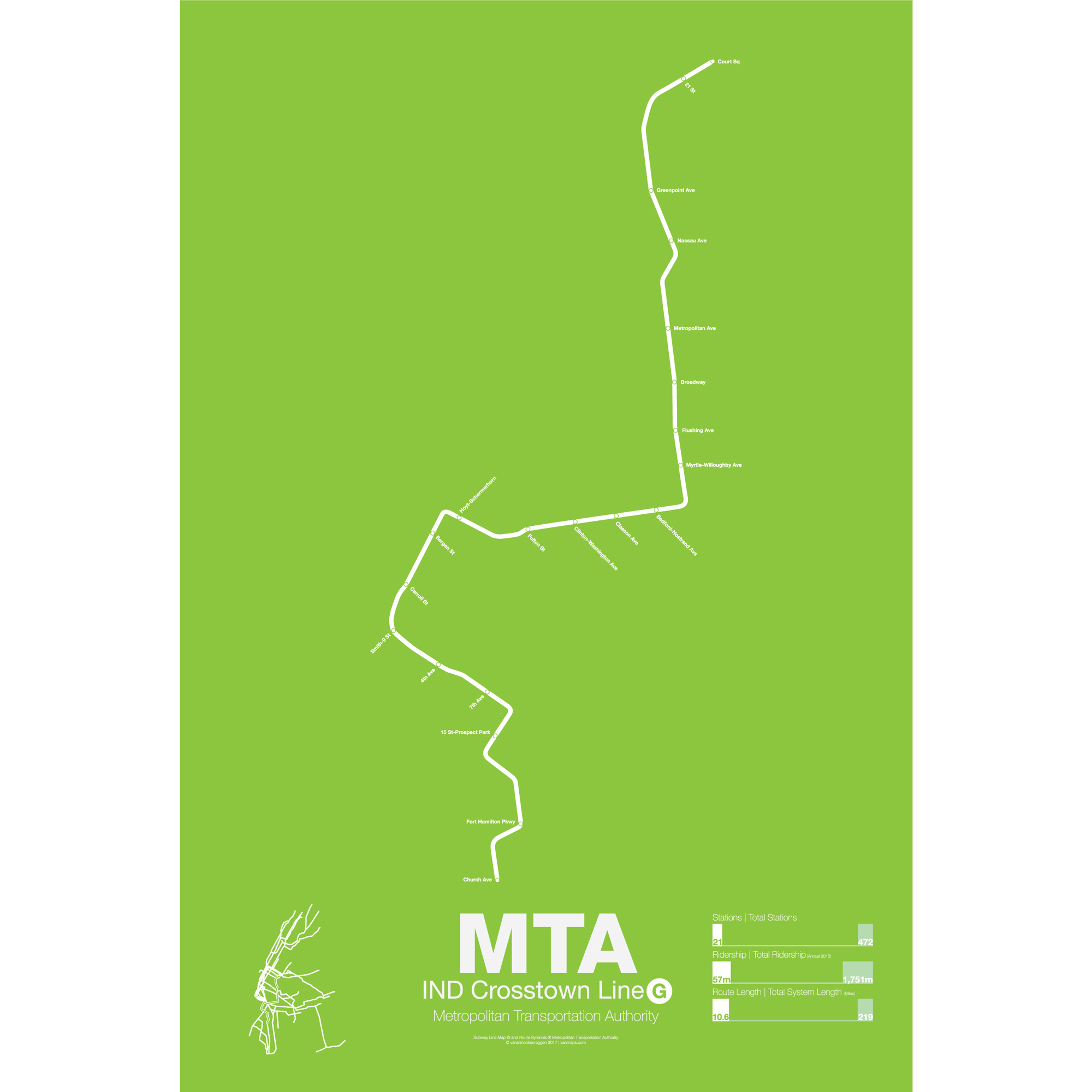
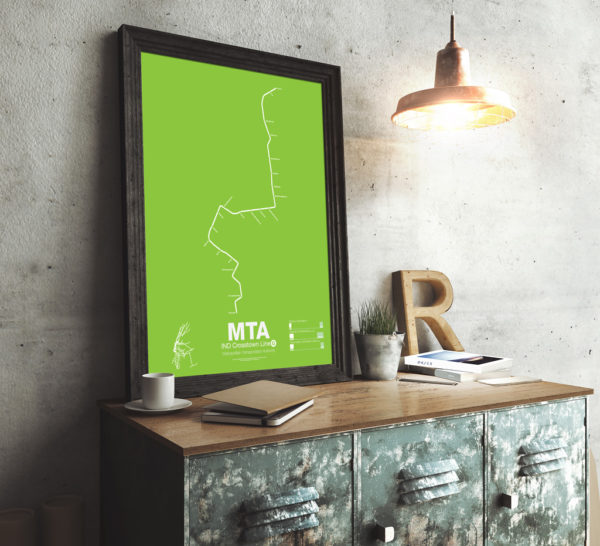 $30.00 – $80.00
$30.00 – $80.00The IND Crosstown line holds the distinction of being the only subway line to never enter Manhattan. Running local between Court Sq in Long Island City, Queens and Church Ave in Kensington, Brooklyn, the G train was opened in segments from 1933 to 1937 to connect the IND Queens Blvd subway to the IND Fulton St and IND South Brooklyn subway. Original plans for a Brooklyn-Queens crosstown line were floated in the 1920s with a line going from Astoria to Bedford-Stuyvesant with a branch going west to downtown Brooklyn and another branch running south along Bedford Ave to Coney Island.
The G train is one of the shortest and least traveled lines in the system and runs through mostly residential areas like Fort Green, Bedford-Stuyvesant, Williamsburg, and Greenpoint. Originally the G served as the only local train along the Queens Blvd line and commuters had to switch at Queens Plaza for express trains into Manhattan. This service proved unpopular and the G was cut back over the years as other trains were rerouted along Queens Blvd.
On the southern section of the line the G train shares tracks with the F along the IND Culver line from Bergen St to Church Ave. Express tracks were built along this section for F trains but, as with service along Queens Blvd, commuters didn’t like having to switch trains so the express tracks remain unused.
Printed on Satin finish 80# cover stock – 220 GSM. Made in the USA! Standard production time is 5 days. Allow more time for shipping.
Select options This product has multiple variants. The options may be chosen on the product page -

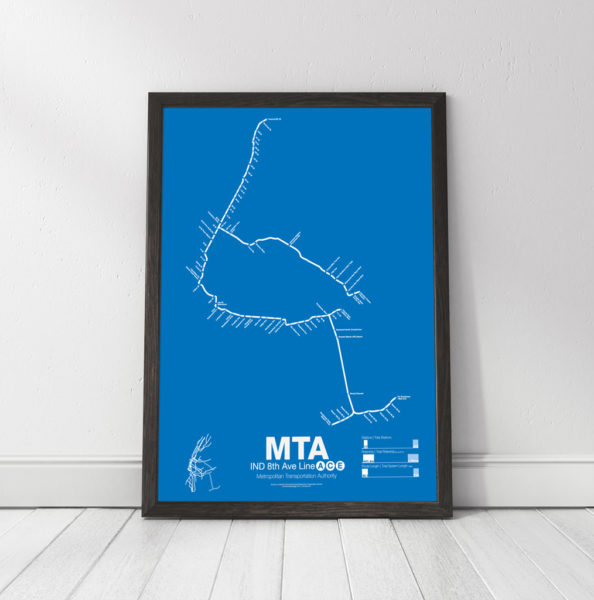 $30.00 – $80.00
$30.00 – $80.00The 8th Ave Line was the first section to open as part of the Independent Subway (IND), a new system built and operated by the City of New York to compete with the privately run IRT in Manhattan and the Bronx and the BMT in Brooklyn and under Broadway. The first major section opened in September 1932 with express and local service from Washington Heights to Chambers St.
The 8th Ave Line shares its tracks with the 6th Ave trains along Central Park West and 53rd St. The A train (made famous by Billy Strayhorn’s Take the A Train) runs from 207th St in Inwood to Fulton St in downtown Manhattan as express while the C train runs all local from 168th St in Washington Heights to Fulton St. From there the line enters Brooklyn and runs out to Ozone Park along the Fulton St subway (not to be confused with Fulton St in Manhattan). The C train terminates at Euclid Ave while the A train continues on to one of three termini: Lefferts Blvd, Rockaway Park and Far Rockaway. The A is the only train with multiple, regular service, termini.
The E train runs local in Manhattan from World Trade Center to 50th St where it splits from 8th Ave under 53rd St heading east into Long Island City and Queens Plaza. The E train is one of the two workhorse express trains running along the Queens Blvd subway to Forest Hills and Jamaica. The E splits from the Queens Blvd subway at Van Wyck Ave and terminates in Jamaica Center.
The majority of the 8th Ave Line is underground and was built specifically for the IND system. The sections of elevated track after Euclid Ave to Lefferts Blvd were recaptured from the existing Fulton St elevated line in the 1940s and the tracks out to the Rockaways where added in the 1950s after being purchased from the Long Island Rail Road.
Printed on Satin finish 80# cover stock – 220 GSM. Made in the USA! Standard production time is 5 days. Allow more time for shipping.
Select options This product has multiple variants. The options may be chosen on the product page -
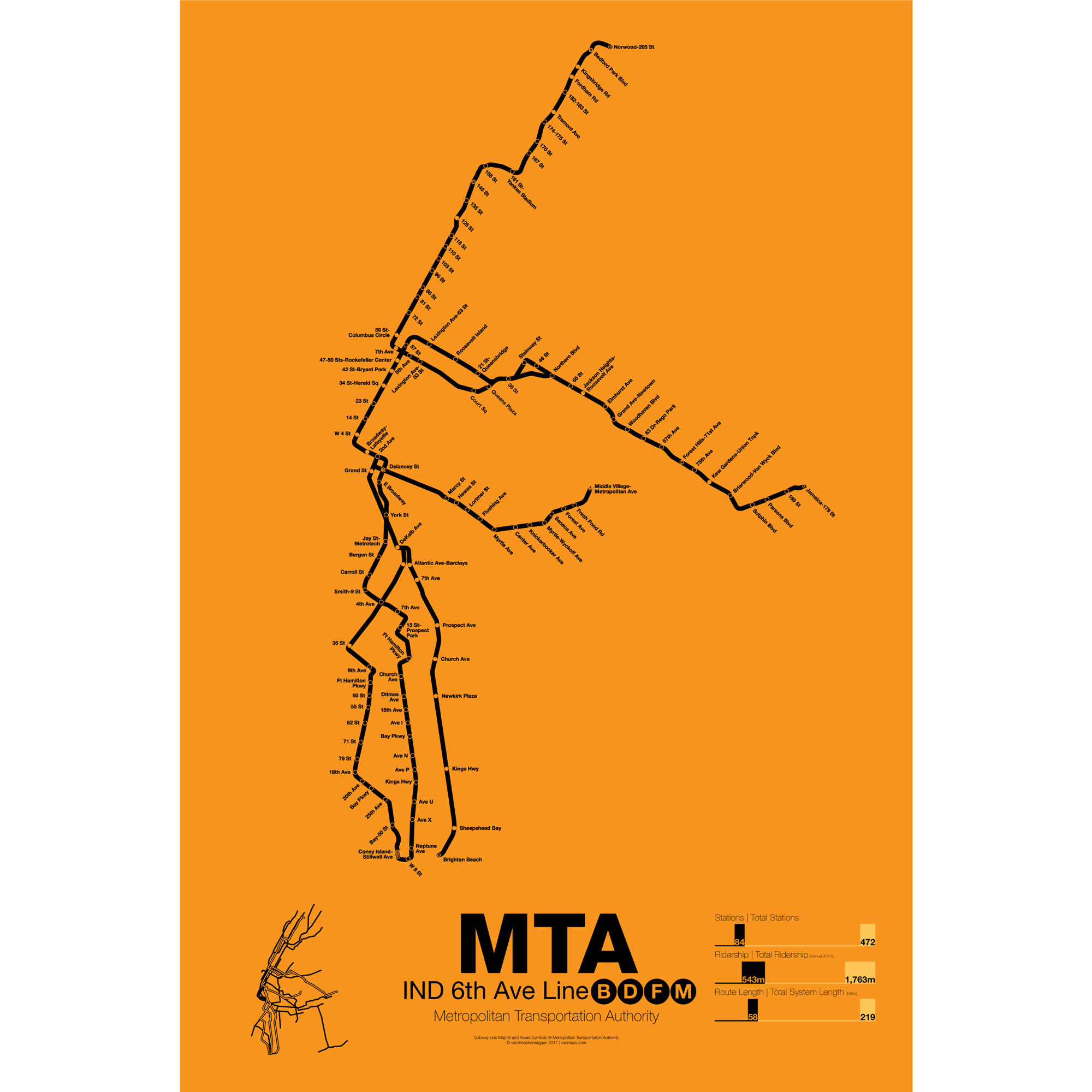
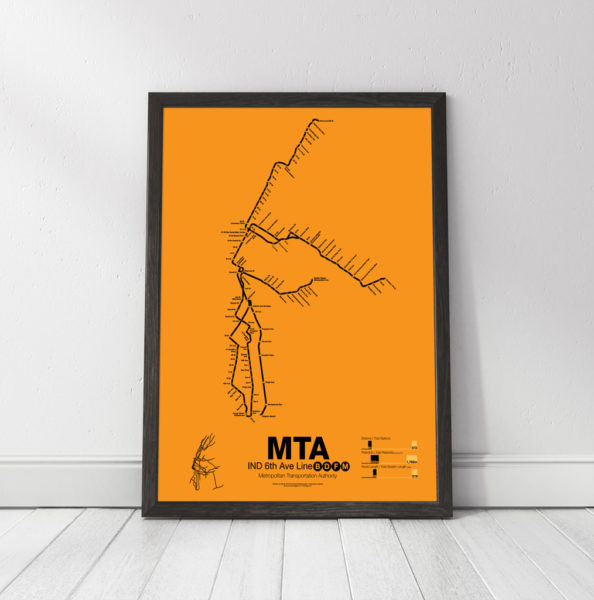 $30.00 – $80.00
$30.00 – $80.00The 6th Ave Line was the second half of the original IND system in Manhattan. The subway was built to replace the old 6th Ave elevated trains and, unlike the 8th Ave Line, was opened in sections between 1936 and 1968. The original sections expanded on the recently opened 8th Ave Line along Houston St to East Broadway, then under 6th Ave from West 4th St to 53rd St. The main trunk subway along 6th Ave was originally built with only two local tracks because of the existing PATH running under 6th Ave. Express tracks were not built until 1967.
B trains run only weekdays from 145th St in Manhattan to Brighton Beach via the Manhattan Bridge and the Brighton Line. At peak times B trains are extended into the Bronx to Bedford Park Blvd. D trains run all times from Norwood-205th St in the Bronx to Coney Island via the Manhattan Bridge, 4th Ave subway, and West End line (elevated). At peak times D trains run express along the Concourse subway. Both B and D trains run express in Manhattan, though B trains make all local stops from 59th St-Columbus Circle to 145th St.
F trains run express along the Queens Blvd subway and enter Manhattan via the 63rd St subway built in the 1960s as a part of the 2nd Ave subway. In Manhattan and Brooklyn F trains run local at all times. In Brooklyn the F shares part of its route with the IND G Crosstown line to Church Ave. After Church Ave the subway becomes elevated to Coney Island.
M trains once ran along the BMT Jamaica line to downtown Manhattan but in 2010 were rerouted along 6th Ave to Forest Hills replacing the short lived V train (which ran from Forest Hills to 2nd Ave). Elevated in Brooklyn, the M train runs through a section of tunnel, built in the 1960s but rarely used, to connect the 6th Ave line to the Williamsburg Bridge. M trains run all local weekdays and as a shuttle from Myrtle Ave to Middle Village nights and weekends.
Printed on Satin finish 80# cover stock – 220 GSM. Made in the USA! Standard production time is 5 days. Allow more time for shipping.
Select options This product has multiple variants. The options may be chosen on the product page -
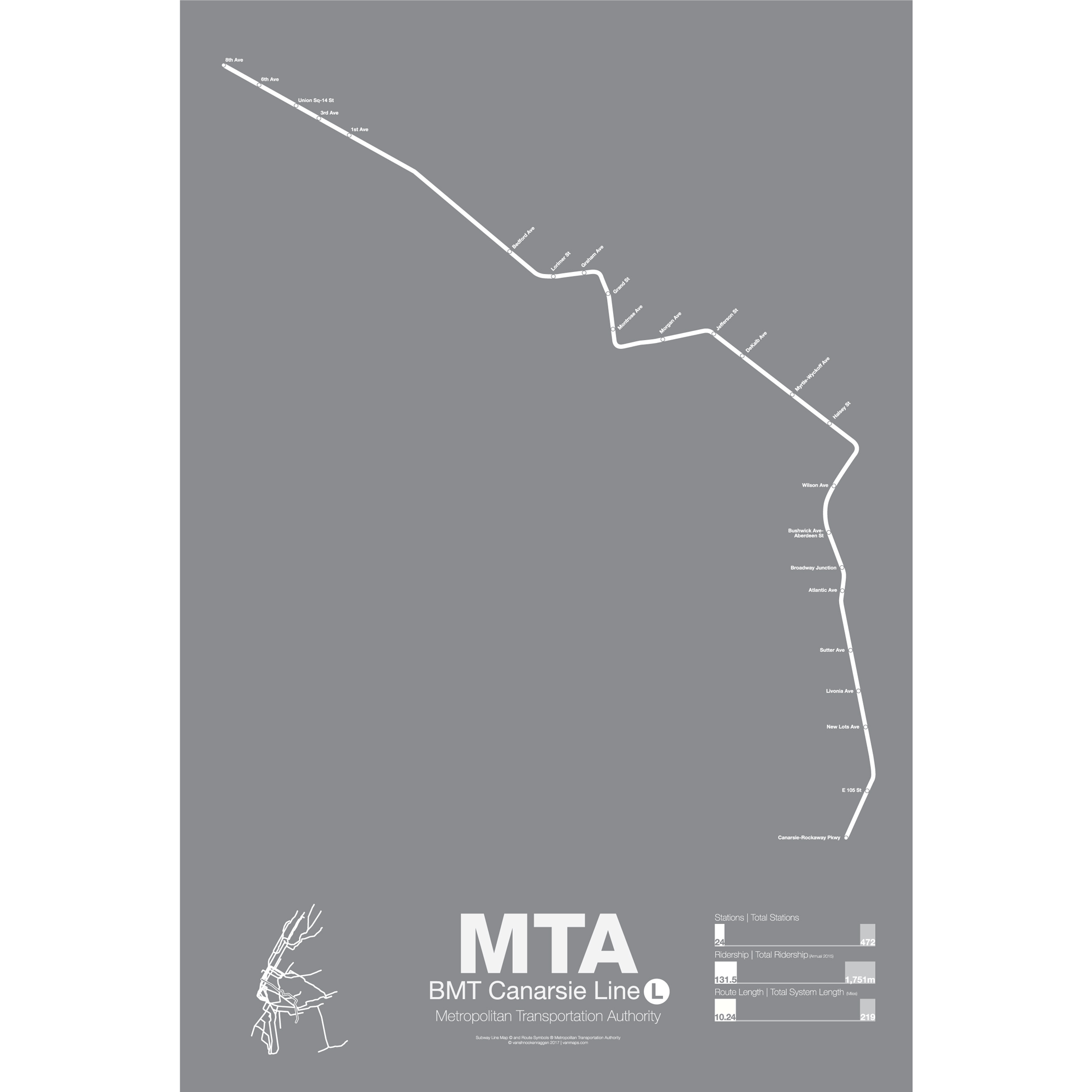
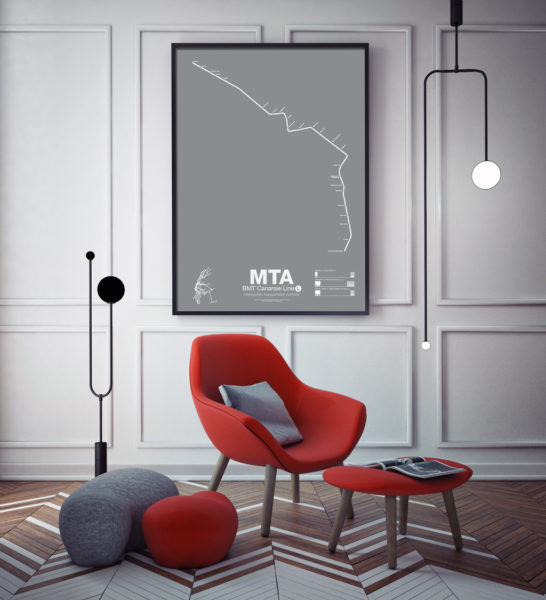 $30.00 – $80.00
$30.00 – $80.00The BMT Canarsie line started its life, like most other Brooklyn lines, as a steam railroad. From Brooklyn Junction to Canarsie it ran until 1906 when it was added to the expanding elevated rail network. Service ran from Williamsburg to Canarsie along the still existing Broadway elevated line. In 1924 the 14th St section in Manhattan opened running from 6th Ave into Williamsburg, making a zig zag through Bushwick and meeting up with the tail end of the elevated line to Canarsie.
The line has only one train, the L, which runs local all times. Original service patterns had trains running to from 14th St/8th Ave (added when the IND 8th Ave line was built) to Canarsie and 14th St/8th Ave to Lefferts Blvd. The Lefferts Blvd branch was suspended when the Fulton St elevated was demolished.
Because the Canarsie line only runs one train line and is separate from other lines it is often used as a testing ground for new technologies. Automated trains, new train cars, and service countdown clocks have all been added and tested on the Canarsie line before being expanded to other lines.
Printed on Satin finish 80# cover stock – 220 GSM. Made in the USA! Standard production time is 5 days. Allow more time for shipping.
Select options This product has multiple variants. The options may be chosen on the product page -

 $30.00 – $80.00
$30.00 – $80.00The BMT Jamaica line is the second oldest continually operated rapid transit line in all of New York City (behind the Franklin Ave shuttle). Originally an elevated train from Driggs Ave in Williamsburg to Gates Ave where it connected with the existing Lexington Ave elevated (not to be confused with the Lexington Ave subway in Manhattan). Opened in 1885 the line was electrified and expanded east to Broadway Junction (1893) then to Jamaica (1913). When the Williamsburg Bridge opened in 1903 it was extended to an underground terminal at Delancey and Essex St on the Lower East Side.
In 1918 a subway was opened connecting the existing terminal at Essex St to a new terminal downtown at Chambers St under the newly constructed Municipal Building. While the elevated line in Brooklyn was only 3 tracks (2 in many places) the new subway under Delancey and Centre Sts was 4 tracks and allowed for express service. The subway was further extended to connect to the new BMT Broadway line subway for service back into Brooklyn.
Three trains run along the BMT Jamaica line. The J/Z runs local from Broad St in Manhattan weekdays (rush hours) and Chambers St all other times to Marcy Ave. After Marcy Ave at rush periods the J runs express to Myrtle Ave and Broadway Junction (running local all other times). After Broadway Junction the J and Z trains operate “skip-stop” service where each train alternates stops. Thus each train only stops at half of the stations. The original elevated track through Jamaica Center was demolished in the 1979 and service was rerouted along the new subway under Archer Ave.
M trains once ran along an elevated line, the Myrtle Ave elevated, from downtown Brooklyn out to Middle Village-Metropolitan Ave. In the 1950s the section of track from downtown to Broadway (Brooklyn) was torn down and service was run from Broad St to Middle Village along the northern portion of the tracks. The M train made this run until 2010 when it was rerouted through the Chrystie St cut to run as local service along 6th Ave. On nights and on weekends the M train is cut back to a shuttle service from Myrtle Ave to Middle Village.
Printed on Satin finish 80# cover stock – 220 GSM. Made in the USA! Standard production time is 5 days. Allow more time for shipping.
Select options This product has multiple variants. The options may be chosen on the product page -

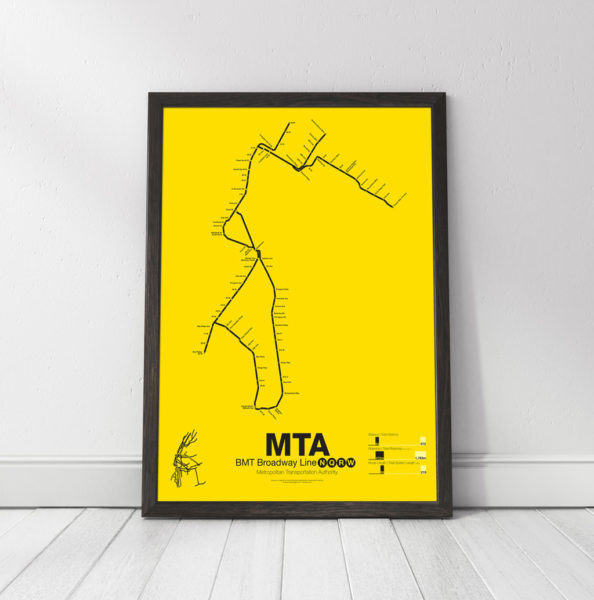 $30.00 – $80.00
$30.00 – $80.00The BMT Broadway line opened in 1917 as the first subway to bring into Manhattan the many existing elevated lines that once terminated in downtown
Brooklyn or City Hall in Manhattan (via the Brooklyn Bridge). When the original IRT subway was built through lower Manhattan businesses along Broadway fought the line running up Broadway for fear of losing business. When the subway opened and proved an instant hit they soon changed their tune and a subway under Broadway was brought back to the drawing board.The N train runs local from Ditmars Blvd in Astoria along an elevated track to Queensboro Plaza, entering Manhattan under 60th St and runs to 14th St as a local train. After 14th St the N runs express to Canal St then over the Manhattan Bridge to Atlantic Ave-Barclays Center. Opened in 1915 to replace the elevated trains which ran through South Brooklyn the 4th Ave subway runs from Atlantic Ave at Flatbush Ave south to 95th St in Bay Ridge. The N runs express to 59th St where it swings east along the Sea Beach line, one of the original steam railroads to Coney Island converted to rapid transit.
The R train runs all local from Forest Hills along the Queens Blvd subway to Whitehall in lower Manhattan then through a tunnel into downtown Brooklyn before making its way south along 4th Ave to 95th St Bay Ridge. The Broadway line was built so that express trains would run over the Manhattan Bridge and local trains would either terminate in lower Manhattan or run into Brooklyn via the tunnel under the East River. This tunnel also connects with the BMT Jamaica line to allow through service for trains from Williamsburg.
The Q runs all local in Brooklyn along the Brighton Beach line (another former steam railroad) into
Manhattan over the bridge. Running express to 57th St it terminates here during most times but at rush periods it extends into Astoria.The 2nd Ave subway opened New Years Day 2017 from 57th St/7th Ave to 96th St/2nd Ave. After nearly a century in planning and a decade of digging the line will be the first part of a larger subway stretching the length of the east side of Manhattan. Phase II will extend it further north to 125th St.
Printed on Satin finish 80# cover stock – 220 GSM. Made in the USA! Standard production time is 5 days. Allow more time for shipping.
Select options This product has multiple variants. The options may be chosen on the product page

